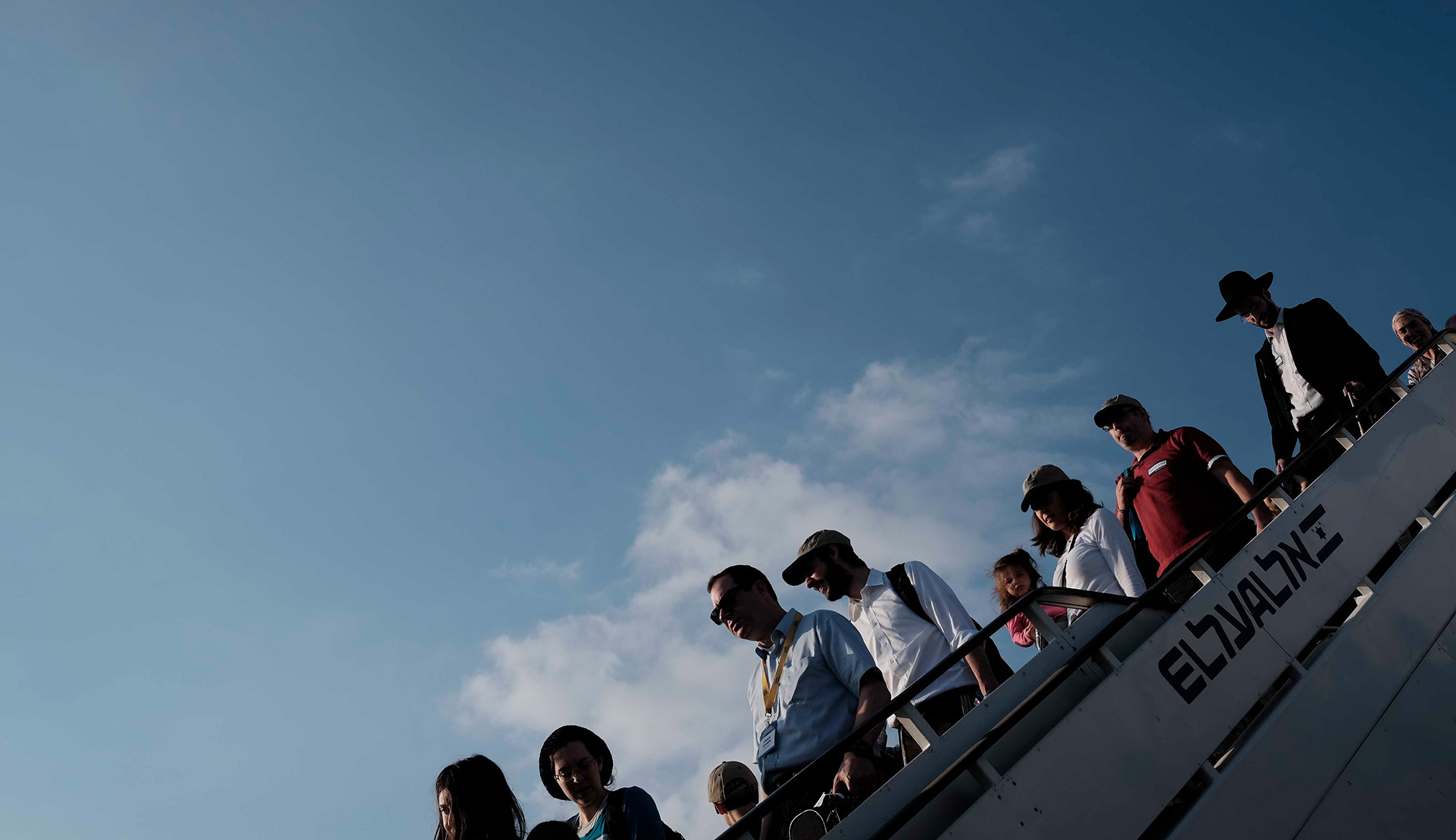In my essay “The Looming War over Israel’s War of Return,” I predicted that Israel’s immigration regime would become increasingly controversial and politicized. I based this forecast on the underlying fears of both the right and the center-left camp, and on the fact that given these fears, both sides have an interest in tinkering with which immigrants they allow into the country. Ofir Haivry and Yehoshua Pfeffer present criticisms of my analysis whose overall tenor is very similar: they both criticize the factual basis of these fears, as well as the demographic categories I use to analyze them, and suggest that Israel may not be quite as divided as I make it out.
Ironically, this kind of response—that Israel’s social crisis isn’t as deep as my article suggested—while clearly well-intentioned, exemplifies the very problem whose seriousness it questions. To show why, I will cite yet another poll (by Channel 12). Shockingly, as of mid-July, 67 percent of Israelis worry about the possibility of a civil war. But here’s a catch: among Israelis who voted for the bloc that opposes Netanyahu, 85 percent now worry about a civil war, while among supporters of the Netanyahu bloc, that number is a much-lower 49 percent (this latter number wasn’t explicitly mentioned in the article, but we can calculate it based on Knesset seats). This means that while not all voters of the right-religious bloc are optimists, almost all of the optimists are supporters of this bloc (perhaps including, and admittedly I’m going out on a limb here, Haivry and Pfeffer themselves). However, if one side overwhelmingly believes that Israeli society is polarized enough to be in danger of civil war, then Israeli society is in fact extremely polarized, even if the other side is more optimistic. If anything, such a stark difference between the two blocs is itself evidence of polarization (even if not evidence of the true likelihood of civil war).
Haivry contends that the category of secular Jew in Israel is too elastic to be useful, since most secular Jews observe at least some religious practices; thus, secular Jews should be seen as continuous with traditionalists. Pfeffer makes a similar point, citing Tommy Lapid’s witticism that 20 percent of Israeli Jews are secular, 20 percent are Orthodox, and 60 percent are Orthodox but non-observant. Both Pfeffer and Haivry note that the 2016 Pew survey shows that religious practices have deep inroads into the world of secular Jews.
Now, I see this as a primarily semantic debate over the dictionary meaning of the word “secular.” But at the end of the day, whether secular means complete irreligion or something else has no importance for my analysis. Whatever it is that Israeli Jews mean when they call themselves secular, all surveys show that it tracks something important, and in terms of worldview and policy preferences, Israeli society is sharply divided between those who apply this label to themselves and those who don’t. Most importantly for the question presently at issue: Jews are extremely politically polarized along self-ascribed secular vs. non-secular identities. According to the same survey I cited in my original essay, 31.5 percent of Likud voters described themselves as secular in 2022, which makes Likud the most secular party in the right-wing bloc. By contrast, the share of seculars in the center-left bloc’s least secular party is 76.6 percent (Yesh Atid). So at least when it comes to voting patterns, there is no continuity at all. Rather, the share of secular voters in Likud is closer to Religious Zionism (13.5 percent) than to the closest party in the rival bloc. According to my own calculations, the share of self-described secular voters is 18 percent in the right-wing bloc and 80 percent in the center-left bloc. Moreover, only 22 percent of seculars voted for the right-wing bloc, but 66 percent of even non-religious traditionalists did. (The share is even higher among all traditionalists taken together.)
All of this means that even if there is smooth continuity between the secular and the religious in terms of level of observance, being a self-described secular strongly correlates with political behavior. In fact, being a self-described secular is a far better predictor of bloc belonging than being a self-described right-winger (66.1 percent of Lieberman and 50.1 percent of Ganz voters). In this context, Haivry’s note that immigrants from the USSR are integrating into Israeli society and thereby becoming more traditional is correct but of little significance; in terms of political polarization, they are going in the opposite direction. (Haivry also notes that the Israeli right has its own soft spot for immigrant groups whose halakhic Jewish status can be doubted, like the Falash Mura from Ethiopia and the Bnei Menashe from India. However, this observation confirms rather than undermines my analysis, since Afro-Asian and Ethiopian immigrants are solidly right-wing constituencies in Israel.)
There is an important qualification to be added to Haivry’s remarks on the old (nominally secular) Zionist establishment’s attachment to Jewish tradition. Israel has changed a lot since the 1950s. Back then, it was correct to say that most Jews were neither secular nor religious, but traditionalists of some sort. Today, this is manifestly not the case: the share of Israeli Jews who define themselves as “traditional” has been on a steady decline since the 1990s. The share of deeply religious (especially ḥaredi) Jews is growing, but so is the share of those who define themselves as “totally secular.” Just one datum: the share of Israeli Jews who fast on Yom Kippur went from 73 percent in 2013 to 60 percent in 2019 and then to 53 percent in 2022. (These polls were based on Internet surveys, which casts some doubt on their absolute accuracy, but still gives a reliable idea of their general trend.) All of these signs point to Israel’s religious polarization as well as political polarization. More and more Jews are very religious, but also more and more are completely secular; and so the continuity between these two groups is ever thinner. This also calls into question Tommy Lapid’s 20/60/20 division of Israeli Jews, cited by Pfeffer. It seems to me that in terms of worldview rather than level of observance—the three relevant worldviews being Jewish exceptionalism, compromise-mindedness, and Israeli “normal-country”-ism—the real numbers are probably closer to 40/20/40.
Why would secular Jews opt to dilute Israel’s Jewish character for mere political expediency, Pfeffer wonders, given that a slight majority of them don’t even recognize Grandfather Clause immigrants as fellow Jews? The answer is that social processes have their own logic, and the people caught up in the heat of events might not yet see the places where their own thinking inevitably leads them. Deputy Prime Minister Yariv Levin’s judicial reform package led many Israeli liberals to call for the “separation” of Israel (a secular, liberal state) from Judea (a theocratic state). Many also frequently declared that “we aren’t one people”; that they, secular Israelis, and right-voting religious Jews, have nothing in common. Such assertions are painful to hear, but they express the way many secular Israelis feel at the present moment. The problem is that once one reaches the conclusion that ḥaredi and religious Jews aren’t one’s brethren, it becomes completely unclear why one shouldn’t invite any “right-thinking,” liberal, productive person to one’s country, Jewish or otherwise. This is why I expect the idea of non-Jewish mass immigration to gain traction over time: it’s the logical end point of the denial of shared peoplehood, even though most of Israel’s disillusioned seculars haven’t consciously reached it yet.
I shall close this section with a note on Haivry’s observation that ḥaredi parties received sixteen seats in 2003 and only eighteen seats in 2022. Strictly speaking, Haivry’s observation wouldn’t undermine my analysis even if it showed that fears of ḥaredi growth are wildly exaggerated. My argument was about the right’s and the center-left’s fears and how they could influence immigration policy, and these fears’ potential to influence policy wouldn’t be diminished even if they were groundless. In this case, however, Haivry’s observation about relatively slow ḥaredi growth is based on an unreliable method: counting the Knesset seats received by Shas and United Torah Judaism (UTJ). There are several problems with this method. First, Shas is not a full-blown ḥaredi party; it attracts a broad constituency ranging from traditional-religious Jews to ḥaredi ones, and many of its voters swing between Shas and Likud from election to election. Second, when demographers speak of exponential ḥaredi demographic growth, they primarily have in mind Ashkenazi Ḥaredim. Sephardi Ḥaredim are only 30 percent of all ḥaredi Jews in Israel, and with a total fertility rate of less than five children per woman and only a 70-percent rate of retention, their net growth rate is barely above the Israeli Jewish average. By contrast, Ashkenazi Ḥaredim have seven children on average, and the community’s retention rate is currently as high as 90 percent.
The ḥaredi growth that most matters politically is best measured by looking at the trajectory of UTJ’s absolute vote count, which isn’t affected by fluctuations in overall voter turnout and the electoral threshold. When we focus on that, we find that the total number of UTJ’s votes more than doubled between 2003 and 2022, corresponding to an annual growth rate of almost 4 percent—very close to the 4.2-percent growth rate of Israel’s Ashkenazi ḥaredi population as estimated from fertility rates. Brash as it might sound, I consider this method so reliable that I’m willing to bet now that if the Knesset completes its term and the next elections are held in 2026, UTJ will get around 320-330,000 votes.
Toward the end of his response, Haivry expresses some skepticism about my reliance on statistics. I’m fully aware of the limitations of dry number crunching, but I think it has at least one advantage. Israel’s present sociopolitical reality is very unpleasant, if not outright scary. In times like this, there is great temptation to adopt comforting narratives, such as the alleged “growing middle” of Israeli Jewry that is neither secular nor religious. Focusing on statistics can serve as a healthy antidote against accepting such narratives when their foundations lack a solid basis in reality.
Yedidia Stern’s response does two things. First, it lists a number of considerations both for and against the Grandchild Clause, coming down (with some caveats) in favor of it. Second, Stern recommends “opening up the gates of conversion” as a solution to the problem of Others—what Israel’s government call those who arrive under the Grandchild Clause and who are therefore not Jewish according to traditional Jewish law. I will mostly focus on this second issue, since I largely find myself in agreement with Stern about cancelling the clause.
I see two potential problems with an easier conversion process as a solution to the problem of Others. The first one is that I’m not persuaded that a significant number of Grandchild Clause immigrants would take this route, even if it were far easier than it is today. Somewhat paradoxically, one reason for this is exactly the Jewish identity of most of these immigrants. According to Alex Rif’s figure, which I cited in my original essay, over 90 percent of such immigrants consider themselves Jewish. If you think you are already Jewish, why would you convert? The very notion might strike you as superfluous, and perhaps even insulting. We already know that 44 percent of secular Jews in Israel don’t accept the halakhic definition of Jewish identity. I’m not aware of what percentage of ex-Soviet immigrants have the same attitude, but it’s safe to assume that it’s significantly higher. So, no matter how lenient and decentralized the conversion process becomes, I doubt that most Grandchild Clause immigrants would be interested in it. After all, they are overwhelmingly secular and see themselves as already Jewish.
The second potential issue with easier conversion as a solution is that we can safely expect conversion to be just as divisive as the Grandchild Clause itself. According to a survey I cited in my original article, 76.6 percent of secular and 56 percent of non-religious traditional Jews support making the conversion process easier for not-halakhically-Jewish immigrants; however, only 31-33 percent of the traditional-religious and the national religious and only 8.5 percent of Ḥaredim support doing so. Overall support among Israel’s Jewish population for easier conversion is somewhat higher than for the Grandchild Clause (53.6 percent for and 41.2 percent against). But just as in the case of the Grandchild Clause, degree of religiosity is strongly correlated with opposition to easier conversion. This means that any coalition that opposes the Grandchild Clause will likely oppose making conversion easier too, and vice versa.
In fact, I think we can safely assume that any attempt to cancel or limit the Grandchild Clause would come in tandem with a parallel attempt to change the status quo about conversion. Currently, Israel accepts non-Orthodox conversions for immigration purposes but not in the context of family law—for the purposes of marriage, for example. It’s reasonable to assume that if the Grandchild Clause were cancelled, at least some would-be immigrants would look for a Reform conversion so they could immigrate anyway. Thus, a right-wing coalition that is determined to stem the arrival of immigrants whom they consider non-Jews would likely seek to block or restrict this avenue as well; after all, from their perspective Reform and Conservative converts are still Gentiles. (In this regard, I don’t share the confidence of Netanel Fisher, who believes that a coalition that cancels or restricts the Grandchild Clause would nonetheless refrain from touching the status quo regarding conversions.)
Therefore, while I share Stern’s view that easier conversion would be a less harmful way of addressing Israel’s “Others” problem than cancelling the Grandchild Clause, I’m less optimistic than him about the feasibility of this plan.
Like the other respondents, Netanel Fisher also argues that the differences between the two camps I describe aren’t as unbridgeable as they might seem at first glance. He also mentions a number of advantages and disadvantages of eliminating or restricting the Grandchild Clause, but unlike Stern, eventually he comes down in favor of a more restrictive immigration policy.
I would like to spend closer attention to Fisher’s second criticism of my essay, which is that my dire prediction is liable to turn into a self-fulfilling prophecy. Like a bad couples’ therapist, he aptly notes, I emphasize the sharp dividing line between two conceptions of Jewish statehood but don’t offer any positive vision for a shared future. I take this criticism seriously, and it had been on my mind when I was writing the original article. I wholeheartedly agree with Fisher’s call for responsible leadership that will help mend the ties.
However, I’m not a political leader or an activist; I’m merely an analyst. I see value in describing Israel’s present social reality as I see it, even if the picture is unpleasant. While I take seriously the risk of voicing a self-fulfilling prophecy, I’m even more worried about analyses based on wishful thinking and imagined bounds between people who don’t feel that they have much in common.
While my main concern is analyzing Israel’s social rift rather than developing a policy for mending it, I do have some ideas for alleviating the present dire situation. As I’ve argued, an important yet tacit driver behind support for the Grandchild Clause (and possibly for, in the future, East European mass immigration) is demographic anxiety in Israel’s liberal camp. As far as I can see, such a fear-driven desire to allow non-Jewish immigration can be avoided by quelling the fears of Israeli liberals by other means. This could happen by adopting, after more than seven decades, a constitution that enshrines certain basic liberties and which cannot be changed without a very large majority. Alternatively, Israel could adopt a federal structure—this is the much-discussed “cantonization” idea—or at least the central government could devolve many of its powers to the municipal level, giving more freedom for cities to determine their own character and more autonomy over their budget.
Either arrangement would meet both the right-religious camp’s and the secular-liberal camp’s basic demands. The Israeli right wouldn’t feel that the state is being governed by the dictates of unelected bodies, especially the Supreme Court. And the liberal camp wouldn’t have to fear that becoming a minority in Israel would subject it to every whim of a permanent religious majority; thus, they wouldn’t feel the need to protect themselves from differential demographic growth by manipulating Israel’s immigration regime.
Thus, in the end I share Fisher’s optimism that there is a way forward and that it’s possible to secure a shared future for all of Israel’s sparring tribes. Whether it gets realized is a matter of political will, leadership, and readiness to compromise.
More about: Demographics, Israel & Zionism, Israeli Judicial Reform








